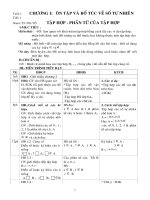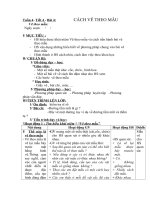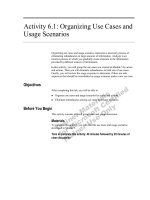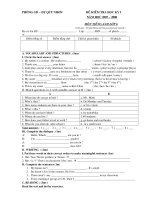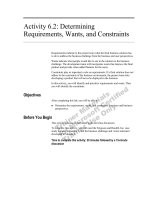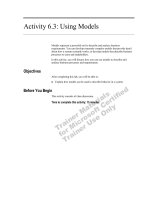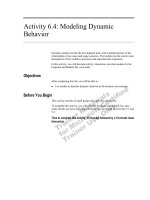Activity 6.4: Modeling Dynamic Behavior
Bạn đang xem bản rút gọn của tài liệu. Xem và tải ngay bản đầy đủ của tài liệu tại đây (89.26 KB, 4 trang )
Activity 6.4: Modeling Dynamic
Behavior
Dynamic models provide the development team with a detailed picture of the
relationships of use cases and usage scenarios. The models provide current state
descriptions of the workflow processes and important task sequences.
In this activity, you will develop activity, interaction, and state models for the
Ferguson and Bardell, Inc. case study.
Objectives
After completing this lab, you will be able to:
!
Use models to describe dynamic behavior in the business environment.
Before You Begin
This activity consists of small group tasks and class discussion.
To complete this activity, you will need the Ferguson and Bardell, Inc. case
study and the use cases and usage scenarios you developed in Activities 5.1 and
5.2.
Time to complete this activity: 50 minutes followed by a 15-minute class
discussion
52 Activity 6.4: Modeling Dynamic Behavior
Exercise 1: Developing Activity Models
!
Develop activity model for the timesheet system (20 minutes)
1. Work in small groups assigned by the instructor.
2. Review the case studies sections that describe the timesheet and data entry
systems.
3. Identify the use cases that describe the flow of activities from the consultant
creating the timesheet to the final invoicing of the client.
4. Describe the workflow process in an activity model in the following table.
Use case Relationship Use case
Activity 6.4: Modeling Dynamic Behavior 53
Exercise 2: Developing Interaction Models
!
Develop an interaction model for the timesheet system (20 minutes)
1. Identify a critical use case in the timesheet system. Choose one where
problems occur often.
2. Develop the usage scenario for the use case.
3. Identify the sequence- and message-based interactions in the usage scenario.
Use Case:
Actor:
System:
Usage Scenario:
Precondition:
Post condition:
Task Sequence Behavior Task Sequence
54 Activity 6.4: Modeling Dynamic Behavior
Exercise 3: Identifying State Relationships
!
Identify state relationships in the timesheet system (10 minutes)
1. Review the results of your work in Exercises 1 and 2.
2. Identify events and critical changes in the task sequence.
3. List the event or change in the task sequence in the table below.
4. When you are finished with this exercise, identify a spokesperson to present
your results to class.
Event in task sequence Description

